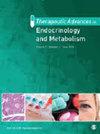Factors influencing height gain in children born small for gestational age treated with recombinant growth hormone: what extent is puberty involved?
IF 3.9
3区 医学
Q2 ENDOCRINOLOGY & METABOLISM
Therapeutic Advances in Endocrinology and Metabolism
Pub Date : 2022-01-01
DOI:10.1177/20420188221083534
引用次数: 1
Abstract
Objective: The objective was to analyze the efficacy of recombinant human growth hormone (rhGH) treatment in children born small for gestational age (SGA) without catch-up growth treated before the onset of puberty, with follow-up until adult height. The influence of demographic and auxological factors on the final response evaluated as adult height and height gain was assessed. Patients and methods: A prospective longitudinal observational study performed in a tertiary hospital, involving SGA patients, who started treatment with rhGH between October 2003 and April 2015. Potential response predictors were evaluated by multiple regression analysis and receiver operating characteristic curves. Results: Of the initial 96 patients included, 61 patients (28 boys and 33 girls) reached adult height. Adult height gain in standard deviation (SDS) was 0.99 (0.8) and 1.49 (0.94), respectively (p < 0.05). An adult height greater than −2 SDS was reached in 75% of the girls but only in 53% of the boys. The pubertal height gain was 22.6 (5.8) cm in boys and 18.8 (4.5) cm in girls. The multiple regression model obtained for total height gain explained 42% of the variability in this variable including sex, height gain during the first year, and the difference from target height at the start of treatment. A first-year height gain of 0.69 SDS was the optimal point for assessing a final height gain greater than 1.5 SDS with a specificity of 70% and a sensitivity of 71%. Conclusion: Most SGA patients achieve normalization of height above −2 SD, the percentage being higher in girls. According to our predictive model, height gain in the first year is the most important variable for predicting good response to treatment. During puberty, there is a loss of height SDS, probably due to a lower total pubertal gain with respect to the reference population, which is more marked in boys.用重组生长激素治疗小于胎龄出生儿童身高增加的影响因素:青春期在多大程度上参与?
目的:分析重组人生长激素(rhGH)治疗出生时小于胎龄(SGA)的儿童在青春期开始前未接受追赶性生长治疗的疗效,随访至成年身高。评估了人口统计学和生长学因素对最终反应(成人身高和身高增加)的影响。患者和方法:在一家三级医院进行的一项前瞻性纵向观察研究,涉及2003年10月至2015年4月期间开始接受rhGH治疗的SGA患者。通过多元回归分析和受试者工作特征曲线评价潜在反应预测因子。结果:在最初纳入的96例患者中,61例(28例男孩,33例女孩)达到成人身高。成人身高增加的标准差(SDS)分别为0.99(0.8)和1.49 (0.94)(p < 0.05)。75%的女孩成人身高大于- 2 SDS,而只有53%的男孩达到。男孩青春期身高增加22.6 (5.8)cm,女孩青春期身高增加18.8 (4.5)cm。获得的总身高增加的多元回归模型解释了该变量中42%的变异性,包括性别、第一年的身高增加以及治疗开始时与目标身高的差异。第一年身高增加0.69 SDS是评估最终身高增加大于1.5 SDS的最佳点,特异性为70%,敏感性为71%。结论:大多数SGA患者的身高在- 2 SD以上达到正常化,女孩比例较高。根据我们的预测模型,第一年的身高增加是预测治疗良好反应的最重要变量。在青春期,身高SDS下降,可能是由于相对于参考人群而言,青春期总增益较低,这在男孩中更为明显。
本文章由计算机程序翻译,如有差异,请以英文原文为准。
求助全文
约1分钟内获得全文
求助全文
来源期刊

Therapeutic Advances in Endocrinology and Metabolism
Medicine-Endocrinology, Diabetes and Metabolism
CiteScore
7.70
自引率
2.60%
发文量
42
审稿时长
8 weeks
期刊介绍:
Therapeutic Advances in Endocrinology and Metabolism delivers the highest quality peer-reviewed articles, reviews, and scholarly comment on pioneering efforts and innovative studies across all areas of endocrinology and metabolism.
 求助内容:
求助内容: 应助结果提醒方式:
应助结果提醒方式:


